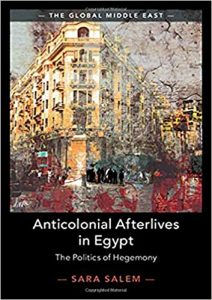In Anticolonial Afterlives in Egypt: The Politics of Hegemony, Sara Salem connects the 2011 revolution in Egypt to the Nasserist project initiated by President Gamal Abdel Nasser and the Free Officers in 1952, putting the theories of Antonio Gramsci and Frantz Fanon in dialogue to argue that Nasserism is the only hegemonic project in modern Egyptian history. This is an excellent, meticulous and highly accessible study of hegemony in Egypt and the postcolonial context in general as well as an illuminating discussion of the emergence and afterlives of anticolonial experiences of social change, writes Haythem Guesmi.
Anticolonial Afterlives in Egypt: The Politics of Hegemony. Sara Salem. Cambridge University Press. 2020.
 Find this book (affiliate link):
Find this book (affiliate link):![]()
In Anticolonial Afterlives in Egypt: The Politics of Hegemony, Sara Salem connects two important moments in Egypt’s modern history: first, its independence from Britain and the creation of the Nasserist project in 1952, initiated by Egyptian President Gamal Abdel Nasser and the Free Officers, a nationalist movement composed of a group of army officers that overthrew Egypt’s last monarch, King Faruq, after a bloodless coup; and second, the popular uprising that toppled the authoritarian regime of President Hosni Mubarak in 2011. In so doing, she argues that Nasserism – the core political, social and economic principles and policies that Nasser developed during his rule and which continue to frame his legacy – is the only hegemonic project in modern Egyptian history. Salem engages with Antonio Gramsci’s analysis of hegemony, Frantz Fanon’s theory of decolonisation and his stretching of Marxism to the (post)colonial context and, to a lesser extent, Edward Said’s concept of travelling theory to discuss the singularity of the Nasserist project, its afterlives and its final collapse during and after the 2011 revolution.
Throughout the introduction and the two main sections that comprise her book, Salem uses Gramsci’s hegemony as a methodological and theoretical searchlight to explain Nasserism’s success in establishing a transformative anticolonial project. She also draws on the same Gramscian analysis to explain the failure of the subsequent regime of President Anwar el Sadat to reproduce a similar political project in the 1970s and 1980s, and the fall of Nasserist hegemonic policies during the 1990s and the beginning of the twenty-first century under Mubarak’s police regime, which eventually led to the 2011 revolution. Her book ends with an urgent suggestion to move beyond Nasserism as a haunting modernist project and a hopeful call for a new and radical humanism alongside the construction of a true decolonial future.
Salem succeeds in making her first book an excellent, meticulous and highly accessible study of hegemony in Egypt and the postcolonial context in general as well as an illuminating discussion of the emergence and afterlives of anticolonial experiences of social change. Well-developed theoretical analyses, thorough discussions of empirical materials and meaningful contributions to the current debates about Marxism, postcolonialism and hegemony make her book a compelling read and lend a wide resonance to her work. But what interests me the most about Anticolonial Afterlives in Egypt is the fluid movements between paradigms and disciplines and the attention to ‘alternate chronologies’ (24) and ‘different tempos’ (207) that reveal a scholar who not only makes a persuasive and lucid case for the thesis under discussion but, most importantly, is convincingly in command of her critical insights.
In the introductory chapter, Salem identifies the 2011 revolutionary uprising in Egypt as the impetus behind her doctoral thesis that turned into this elegant book. Rather than delving into another contemporary contextualisation of the Egyptian revolution, she posits that the 2011 events were a secondary revolution that connects back to the first enduring revolution of the Nasserist era and its balanced hegemony between consent and coercion. While she acknowledges that this argument has been discussed by many scholars, Salem suggests a double theoretical movement between Marxism and postcolonialism to join these two revolutions in a singular trajectory. To do this, she reads Gramsci’s and Fanon’s works in relation to Egypt’s political and economic history, and she explores how the context of reception illuminates new understandings and adaptations of their theories.

In ‘Anticolonialism and its Discontents’, Salem carefully signals that Gramsci’s hegemony refers to a structure of power in its civil and political forms and ‘the process whereby one class exerts influence over society so that other classes follow its political and economic project’ (36). This is ‘accomplished when a social force is able to transcend its narrow interests and universalize them through moral and intellectual reform’ (36) as well as through leadership in ‘the embedding of coercion within consent so it appears legitimate, necessary, or unintended’ (231).
To ground this Gramscian concept in Egypt and in the colony/postcolony in general, Salem links both Marxism and postcolonial theory through a Gramscian analysis of Nasserist hegemony and its aftermath in Egypt. She also offers a postcolonial adaptation of Gramsci’s theory through Fanon’s methodology of stretching out Marxism ‘to contextualize the specificity of capitalism in the colony without completely disregarding the assumptions underpinning Marxism’ (62) and his conception of a neocolonial dependent bourgeoisie. For Fanon, capitalism and Marxism took distinct forms in the colonial context, especially when it came to the creation of a ruling class that remained dependent to a large extent on (neo)colonial and international capitalism.
Reading Gramsci through Fanon and Fanon through Gramsci allows Salem to move freely between historical moments in Egypt from the pre-history of the Nasserist’s anticolonial project in the early twentieth century to the present day, between Italy and the postcolonial world, between various paradigms such as political economy and historical materialism. For instance, Salem rehistoricises the role of foreign capital in undermining the anticolonial resistance of Egypt’s Bank Misr and its national capitalists in the pre-independence period. Founded in 1920, the challenges faced by Bank Misr to establish a national independent industrialisation, despite the aspirations of the Egyptian elite, and its eventual downfall show the influence of British capital in colonial Egypt and the debilitating power of the colonial international, the economic and political structures of global capitalism and imperialism.
In the second and lengthiest chapter, ‘Hegemony in Egypt: Revisiting Gamal Abdel Nasser’, Salem discusses the political, economic, social and cultural motivations that underpin her central argument that Nasserism is the first and last hegemonic project in modern Egypt. She underlines how pre-1952 anticolonialism, the creation of a genuine historical bloc that allowed Nasserism to organise Egyptian society in its own image and universalise its project, the balance between economic nationalism and state-led capitalism, political internationalism and the consent of Egyptian civil society all resulted in the success of Nasserist hegemony and the creation of powerful legacies that continue to reverberate throughout Egypt’s modern history. Salem adds nuance to understandings of Nasserism as a hegemonic project that established a balance between consent and coercion and arguably an independent ruling elite, yet was also ‘built on internal contradictions, among them the continuation of capitalist development, the absorption and weakening of radical movements such as labour, and the reproduction of colonial institutions such as the nation and nationalism’ (83).
In the last section of the book, ‘Hegemony and Its Afterlives’, Salem examines the afterlives of Nasserism and its gradual decline through the rise of coercive hegemony under el Sadat, from 1967 to the mid-1990s, and Mubarak, from the mid-1990s to 2011. Salem uses Fanon’s criticism of the dependent bourgeoisie in the postcolony to explain how the rapid economic neoliberalism of el Sadat’s project of ìnfitah (‘opening’) to transnational capital and the absence of a historical bloc weakened the Nasserist hegemonic project. Complicating this Fanonian argument, she argues that Fanon’s prediction of the rise of a native bourgeoisie that is ideologically and economically dependent on former colonies did not materialise under Nasser but rather under el Sadat’s neoliberal rule.
This failure to further Nasserist hegemony initiated a debilitating period of transition that Gramsci describes as an interregnum where the old political rule is dying and the new order fails to design and implement a viable continuity. Salem further adapts this Gramscian concept to analyse the appearance of various ‘morbid symptoms’ under Mubarak’s regime in the 1990s and 2000s. During what Salem calls ‘empty time’, ‘a time of crisis during which politics pauses’ (24), police brutality, rampant corruption, poverty and violent electoral politics turned Egypt into a dictatorship. The association of a corrupt caste of businessmen and the military with aggressive neoliberal restructuring and financialisation of the Egyptian economy resulted in the inability ‘to create either a historical bloc or hegemony’ (243) and led to deep reliance on ruthless coercion to eliminate resistance, which eventually signalled the fall of Nasserist hegemony.
In the book’s conclusion, ‘Haunted Histories and Decolonial Futures’, Nasserism is explored as a haunting political project, because its powerful and enduring political and economic structures forced subsequent regimes to engage with them to design their fragmented hegemonic projects. But also, most importantly, Nasserism still haunts ‘as a kind of historical alternative that never quite materialized; and as a project filled with social violence that continues to haunt contemporary Egyptian politics today’ (260). The failure of el Sadat and Mubarak to break with Nasserism’s key policies, especially economic liberalism, highlights its haunting dimension, but also suggests the need to depart from Nasserism’s mastery over Egypt’s future because its hegemonic project has debilitated the capacity of labour and feminist movements particularly to renew their political and social programmes. To resolve this impasse, Salem turns to Fanon’s argument for a true decolonial future that challenges the desire to imitate and reproduce imperial hegemony in Europe and elsewhere. She argues that Fanon’s radical humanism and his call for a new world propose the possibility of an alternative anticolonialism and a true decolonisation.
While it unpacks complex issues and multiple threads in discussing Nasserism’s hegemony, Anticolonial Afterlives in Egypt underdevelops some of the concepts and analyses that would have been a welcome addition to Salem’s book. For instance, key concepts such as travelling theory, the colonial international, empty time, social violence and haunting could have been further theorised and explored in relation to the central threads on hegemony and its afterlives. Surprisingly, the author’s discussion of Fanon’s dependent bourgeoisie early in her book was less about its connection to hegemony in the postcolony and more about the reception of Fanon in the Middle East. Salem’s arguments would also have benefited from a deeper engagement with Roberto Roccu’s The Political Economy of the Egyptian Revolution since both studies argue that Nasserism is the only successful system of hegemony in post-independence Egypt and that the 2011 revolution announced its collapse. Besides, there seems to be an unresolved debate in relation to the interconnections between the afterlives of Nasserist hegemony and (neo)colonialism. To what extent do the afterlives of colonial hegemony that precede Nasserism explain the failure and collapse of the Nasserist hegemonic project? Finally, such an elegant book merits a more careful editing to avoid occasional spelling errors, especially in the concluding chapter.
Overall, Anticolonial Afterlives in Egypt is a valuable addition and excellent resource for anyone studying and teaching, or generally interested in, hegemony, postcolonialism, Marxism as well as decolonisation in Egypt and in the postcolony in general.
Note: This review gives the views of the author, and not the position of the LSE Review of Books blog, or of the London School of Economics. The LSE RB blog may receive a small commission if you choose to make a purchase through the above Amazon affiliate link. This is entirely independent of the coverage of the book on LSE Review of Books.
Image Credit: Sarah.249 (CC BY 2.0).







